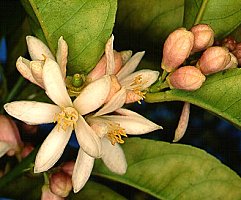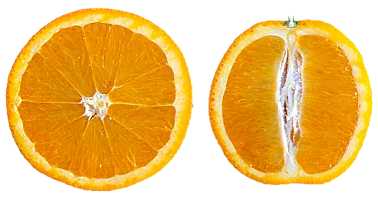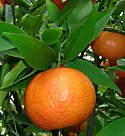|
Citrus (Orange, Lemon, Lime, Grapefruit, Naartjie
genus) Life
> eukaryotes >
Archaeoplastida >
Chloroplastida
>
Charophyta > Streptophytina > Plantae (land plants)
> Tracheophyta (vascular plants) > Euphyllophyta > Lignophyta (woody plants)
> Spermatophyta (seed plants) > Angiospermae (flowering
plants) > Eudicotyledons > Core Eudicots > Rosids >
Eurosid II > Order: Sapindales > Family: Rutaceae

Flower of Citrus limon (Lemon) |

Cross-section and longitudinal section through Citrus sinensis fruit
(Orange). |
|
Native from northern India to China and south through
Malaysia, the East Indies and the Philippines. About seven species and more than
seven hybrids are cultivated in southern Africa including familiar fruit such as
oranges, naartjies, grapefruit and lemons.
The genus Citrus is native to southeast Asia,
occurring from northern India to China and south through Malaysia, the East
Indies and the Philippines. They are all small
evergreen trees and shrubs, usually with spines on trunks and branches. The
ecology of wild species is now hard to establish because of drastic habitat
modifications in the region as well as extensive hybridisation between wild and
domesticated plants. The history of domestication has also been hard to
establish because archaeological evidence is lacking and it has been difficult
to link names and descriptions in ancient accounts with the actual species we
know today. Records of domestication go back to about 500 BC.
Citrus fruits are high in vitamin C, flavonoids,
acids and volatile oils. They contain coumarins such as bergapten which make the
skin sensitive to sunlight. Many citrus species and varieties are not cultivated
for producing fresh edible fruit but are sour and used for other purposes: oil
is extracted from freshly open flowers (e.g. neroli oil from Bergamot) and used
in perfumes. Leaves are used for flavouring foods and for medicinal infusions.
Essential oils are extracted from leaves and unripe or ripe fruit and used in
flavourings and for scenting toiletry products. The skin of fruit is used for
making marmalade.
The 4 original wild species from which the main hybrid
species are derived
|
Citrus aurantifolia (Lime)
Originates from tropical Southeast Asia, where it can still be found wild.
Cultivars have been developed based on sweetness (usually sour), size,
shape (round or oblong) and colour (yellow or green). All varieties have
relatively thin skins. Lime fruit are used for preserves, garnishes
and juices. Citral oil is extracted for use in perfumes. |
|
Citrus
maxima (Pummelo,
Pamplemousse, Shaddock) Thought to have originated in Sourtheast Asia. By 300 BC, Citrus grandis
was being grown commercially in China. It is important in Chinese medicine
and trees are grown also for their beauty and fragrance. Citrus grandis is not grown commercially these days but is
still grown as a garden tree. |
|
|
Citrus medica (Citron)
Citron is thought to be native to India and then to have spread
prehistorically, through cultivation, to other parts of Asia, and Europe.
Fruit are yellow, ovoid-oblong and can be large, measuring up to 30 cm
long. They have a very thick rind and sour juicy parts. The rind is used
in making candied confectionery but Citron is used predominantly for
medicinal and ritual purposes rather than for food. |
|
|
Citrus reticulata (Mandarin, Satsuma and Tangerine,
Naartjie)
The Mandarin was probably domesticated in tropical Southeast Asia. By 500
BC it was known in China and by 300 BC it was being grown commercially
in central China. By 400 AD, grafting methods were being used to clone
favourable varieties. It was introduced to Japan at
an early stage, and it was here that the Satsuma variety was developed. Despite
its popularity in Asia, it was only in the 1800's that Citrus
reticulata was established in Europe, North Africa, West Indies, North
and South America, and Australia. |
 |
Hybrid species
|
Citrus x aurantium (Seville, Bergamot or Sour
Orange)
Hybrid between Pummelo
Citrus grandis and
Mandarin Citrus reticulata.
Citrus
aurantium orginated in China and seems to have entered the written
record there by 300 BC. Because of its sour and bitter taste, Sour orange is not usually eaten raw but used for:
(1) making marmalade and candied peel; (2) producing essential oils for use in
soaps and perfume; (3) scenting tea using the flower buds; and (4) fruit
extracts are used to flavour soft drinks and the aromatic oil is used in
distilling certain liqueurs. Bergamot yields
oil from the flowers which is used in perfumery (e.g. in Eau de Cologne),
and which is the substance added to Earl Grey tea to give it that
distinctive flavour. |
|
|
Citrus x limon (Lemon)
Hybrid between Citron Citrus medica and Lime
Citrus aurantifolia.
The place and date of origin of the Lemon is uncertain but it probably
came from China. Lemon is used for making lemonade, it is used in
drinks, and for flavouring a wide variety of foods. The essential oil
from Lemon is known as cedro oil, and is used as a flavouring in the
food industry and is also used in soaps, detergents and perfumes. |
|
Citrus
x limonia (Canton
Lemon or Rangpur Lime)
Hybrid between Mandarin Citrus reticulata and Lime
Citrus aurantifolia.
Thought to have originated in Southeast Asia and spread to China and India
in cultivation so that by 1000 AD it was in southern China. This species
is evidently grown widely as a garden tree in subtropical regions. |
|
Citrus
x paradisii (Grapefruit) Hybrid between Pummelo
Citrus maxima and Sweet Orange
Citrus
sinensis.
This hybrid species is thought to have originated on the island of
Barbados in about 1750. Further varieties of Grapefruit were developed
mainly in Florida and Texas, USA. Grapefruit are usually eaten by
cutting them in half and scooping out the flesh, often with a little
sugar added to relieve the bitterness. They are also used in juices and
fruit salads. |
|
|
Citrus x sinensis (Edible, Sweet, Valencia,
Navel Orange)
Hybrid between Pummelo Citrus maxima and Mandarin
Citrus
reticulata. Although originating from the same
parent species as Citrus aurantium, the actual parents were different
varieties to those of Citrus aurantium. There are clear records of
Citrus sinensis in China only by the 1100's and in India by the 1300's.
By the 1400's it had spread to the Mediterranean. From the mid 1600's
onwards, European colonists spread it around the world's tropical regions.
The Navel variety originated in Bahia, Brazil in the 1800's. |
 |
Additional species recorded as being cultivated in
southern Africa
List from Glen (2002). The species and hybrids listed above
have also been cultivated in southern Africa.
Citrus jambhiri (Rough lemon)
Similar to the lemon and used in a similar way. Origin uncertain - possibly
northwestern India. |
|
Citrus limettoides (Sweet lime)
Native to India. |
|
Citrus volkameriana (Volkamer lemon)
Often used as a root stock for other citrus types because of being resistant
to diseases. |
|
Citrus x limonia |
|
Citrus x nobilis (Tangor) |
|
References
-
Brown, D. 2002. The Royal Horticultural
Society New Encyclopedia of Herbs and their Uses. Dorling Kindersley,
London.
-
Sauer, J.D. 1993. Historical geography of
crop plants - a select roster. CRC Press, Boca Raton, Florida.
Text by Hamish Robertson
|
